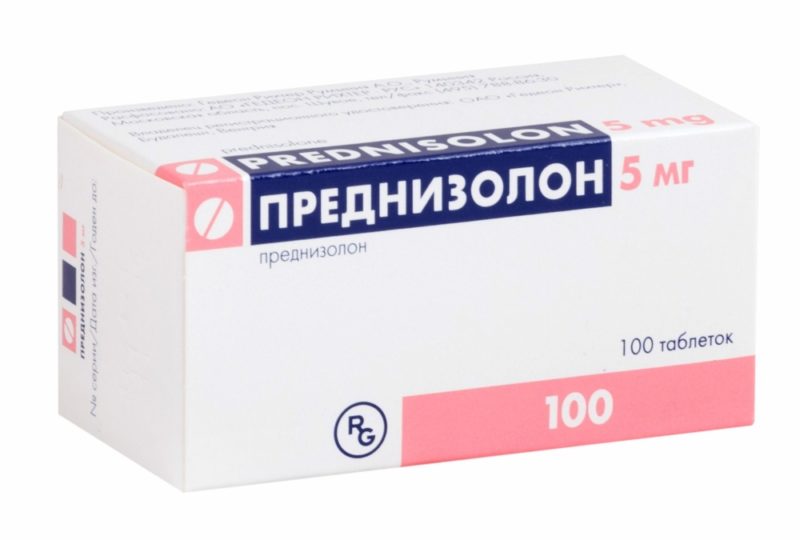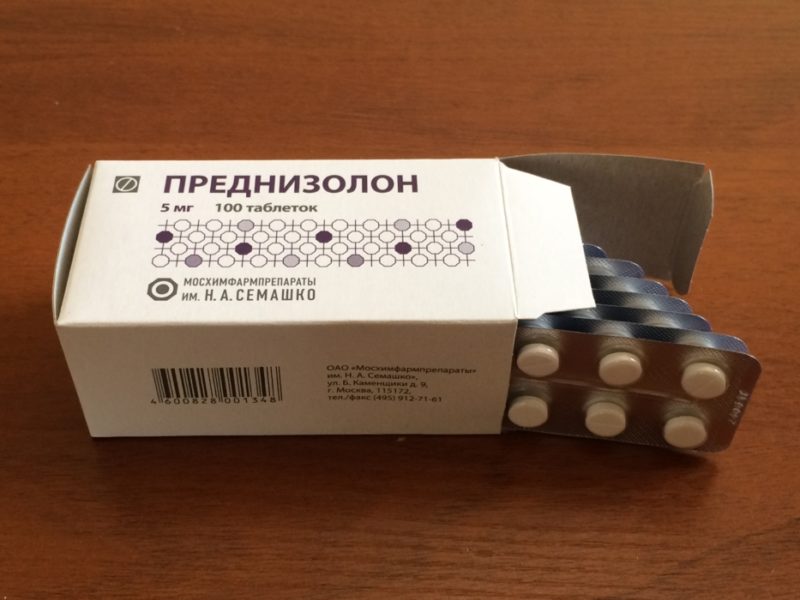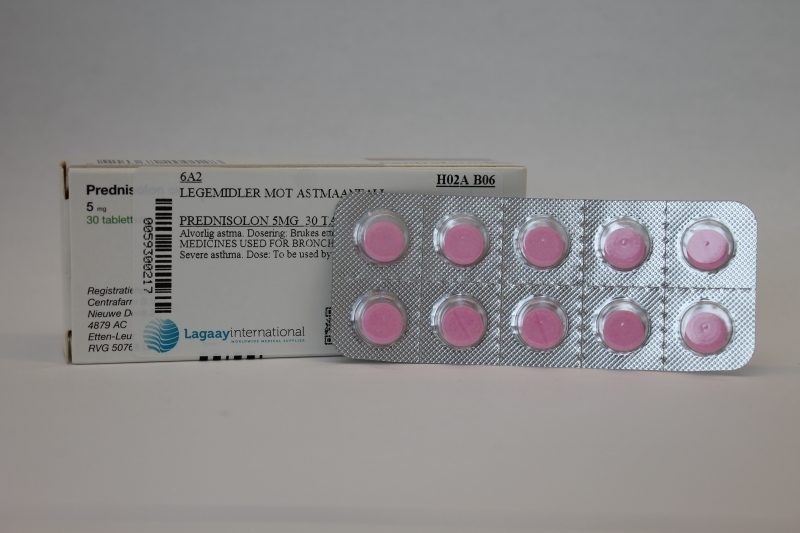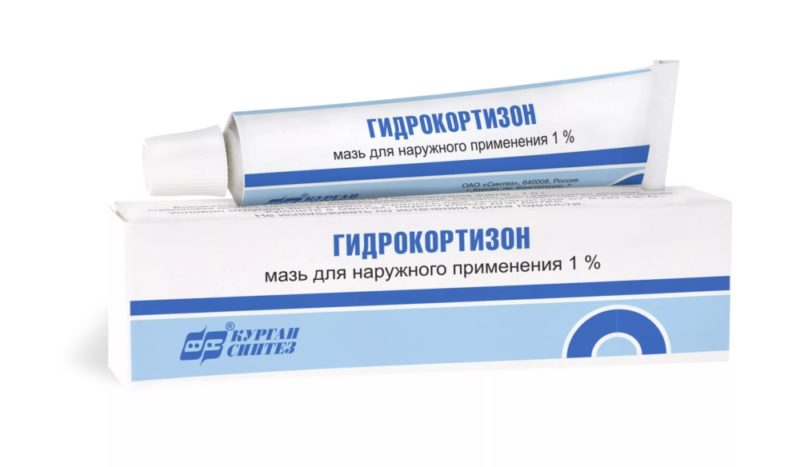There are drugs whose spectrum of action includes a very large number of diseases. The instructions for use of prednisolone in tablets or solution for injection describe more than a hundred pathologies for the treatment of which this medicine is prescribed. It is included in the first aid list for some conditions and is used for resuscitation.
Material Content:
The composition of the drug
The drug is available in several versions. For emergency care, a solution for intramuscular and intravenous administration is used. 1 ml of the drug contains 30 mg of prednisolone. To maintain the properties of the substance and maintain a liquid state, metabisulfite and sodium hydroxide, nicotinamide, water for injection and disodium edetate are added to it. The package contains 3, 5 or 10 bottles.
And Prednisolone tablets with 5 mg of active substance in 1 pc are also available. In addition to it, the medicine contains potato starch, magnesium stearate, lactose and gelatin. The package contains 100 tablets.
For topical application, eye drops with 0.5% of the active substance and an ointment with the same concentration were created. They also contain the synthetic glucocorticoid prednisolone.In dry form, it is a powder of white or yellowish color without a characteristic odor, but with a bitter taste.
pharmachologic effect
Prednisolone refers to glucocorticoid drugs that relieve inflammation, reduce allergic manifestations, suppress immunity, have an anti-shock effect and can be used as hormone replacement therapy. The active substance affects cellular receptors, resulting in the formation of an active complex. It enters the nucleus, where through fusion with DNA it triggers the formation or suppression of messenger RNA. This changes the structure of the protein, which acts as the initiator of the cell.
The tool inhibits the synthesis of inflammatory mediators, because of which the reaction quickly localizes and stops. It also inhibits the action of the collagenase enzyme, which is responsible for the destruction of bone and cartilage due to rheumatoid arthritis. The anti-shock effect is due to increased synthesis of blood cells by the bone marrow, and therefore the number of platelets and red blood cells increases. At the same time, the concentration of leukocytes decreases, which prevents an active fight against infectious agents.
Allergy symptoms are relieved by reducing the number of basophils and mediators of an immediate type reaction in the blood. Suppression of immunity occurs due to degenerative effects on lymphoid tissue and lymphocytes. In this case, complement decomposition is initiated and suppression of macrophages and leukocytes, responsible for the reaction to foreign bodies, is launched.
Prednisolone triggers the synthesis of liver enzymes and triglycerides. It increases the amount of glucose in the blood and stimulates gluconeogenesis. The action of the drug provokes leaching of calcium from bone tissue and excretion of potassium from the body.
well absorbed from the gastrointestinal tract. Its maximum concentration is reached 1.5 hours after administration. Prednisolone is able to penetrate through the placenta and into mother's milk. Excretion of metabolic products occurs through the kidneys, and 1/5 of the remain unchanged.
Why is prednisolone prescribed?
The drug has a large list of indications.
Prednisone helps with the following conditions:
- digestive system diseases (cirrhosis and liver fibrosis, vomiting and nausea, ulcerative colitis, chronic hepatitis of unspecified genesis, regional enteritis, subacute and acute renal failure, infectious gastroenteritis and diarrhea due to dysentery or bacterial damage);
- blood pathologies (thrombocytopenia of secondary origin, lymphogranulomatosis, lack of granulocytes, lymphocytic leukemia, aplastic constitutional or unspecified anemia, idiopathic thrombocytopenic purpura, hemolytic autoimmune etiology, myelogenous leukemia, red bone marrow aplasia);
- diseases of the respiratory system (pulmonary sarcoidosis, unconfirmed tuberculosis, lung or bronchial cancer, pneumonia of unknown origin, berylliosis, allergic and vasomotor type rhinitis, pulmonary fibrosis of the interstitium of the lungs, asthma, pneumonitis due to reflux of vomit and food, increase in the number of neutrophils in the lungs asthmatic status);
- skin lesion (bullous lesion of unspecified genesis, urticaria, pemphigus, seborrheic, exfoliative, atopic, unspecified or contact type dermatitis, Lyell's syndrome, other erythematous conditions, chronic lichen simplex, keloid scar, psoriasis, including arthropathy discoid type, rashes of a non-specific type, hair loss of a non-scarring nature of unspecified genesis, other diseases of subcutaneous fatty tissue and skin);
- pathologies of the nervous system (cerebral edema, meningitis of tuberculous origin, multiple sclerosis);
- diseases of the organ of vision (inflammation of the sclera, blepharitis, iridocyclitis, corneal ulcer, acute conjunctivitis of the atopic or unspecified genesis, inflammation of the optic nerve, keratitis, episiscleritis, endophthalmitis, blepharoconjunctivitis, chorioretinal inflammation, trauma, eye injury)
- endocrine disorders (hyperthyroidism, failure of the adrenal cortex, primary, refined and unspecified, thyroid coma or crisis, subacute inflammation of the thyroid gland);
- pathology of metabolic processes (increased concentration of calcium in the blood);
- systemic diseases (rheumatic fever with or without heart damage, unspecified arthrosis, adult Still's disease, juvenile or rheumatoid arthritis, systemic lupus erythematosus, ankylosing type spondylitis, polymyositis, gout idiopathic course, systemic sclerosis, unspecified polyarthritis, ischiasis, ishiasis synovitis of unspecified genesis, adhesive capsulitis localized in the shoulder region, nodular polyarteritis, unspecified enthesopathy, microangiopathy of thrombotic origin I, bursopathy and spondylosis of unspecified genesis);
- allergic reactions (inadequate reaction to food, including anaphylactic shock, Quincke's edema, allergy of unspecified etiology, other blood serum reactions);
- recovery after myocardial infarction;
- shock of an unspecified nature;
- acute nephritic and nephrotic syndromes;
- poisoning with drugs for local treatment;
- condition after transplantation of tissues or organs;
- adverse outcome with certain medications.
A medication has a large number of therapeutic effects, so it can be prescribed with a whole list of diseases. It rarely acts as a monotherapy, usually being part of a complex. The choice of form of release of the drug depends on the severity of the condition and the location of the lesion.
Instructions for use and dosage
The dosage of prednisolone is determined by the attending physician after examining the patient and establishing the severity of the lesion. When using the injection, the age and weight of the patient, as well as a preliminary diagnosis, are taken into account. The medicine is administered intravenously or intramuscularly.
Important! When the patient is stabilized, they are transferred to a tablet form.
The dose depends on the age and weight of the patient. Children are prescribed from 0.14 to 2 mg per kg of body weight per day. The frequency of reception is 3-4 times.
Adults are recommended to consume from 5 to 60 mg of active substance per day. The maximum amount is limited to 200 mg. Prednisone should be taken once in the morning.
If the patient has missed one of the tablets, it is worth continuing treatment with the previous dosages at the same time.
Attention! A double amount is not worth it.
The drug withdrawal schedule implies a gradual dose reduction of 1 mg in a few days. This is necessary in order for the adrenal cortex to begin to produce its own hormones.
During pregnancy and breastfeeding
Since glucocorticosteroids pass through the hemato-placental barrier, their use during the period of gestation may cause him adrenal dysfunction. Therefore, the appointment should be carefully justified and be of greater benefit to the mother than the risks to the fetus. After the birth of such children are carefully examined.
Women who are breast-feeding a child are recommended to introduce the mixture during the treatment of corticosteroids. This will help to avoid the development of possible complications. Such restrictions are due to the fact that the agent penetrates 1% of the milk of the mother.
Drug interaction
Treatment with steroidal anti-inflammatory drugs often takes place in combination with other drugs. This can cause unpleasant consequences due to the interaction of various groups of drugs.
Care should be taken to combine Prednisolone therapy with the following agents:
- epilepsy medications, rifampicin, barbiturates, ephedrine, antihistamines (reduce the effect of glucocorticoids);
- cardiac glycosides (increase the risk of arrhythmias);
- anticoagulants, uro- and streptokinase, non-steroidal anti-inflammatory drugs (increase the chances of bleeding in the organs of the gastrointestinal tract);
- paracetamol, muscle relaxants of the depolarizing type (can provoke edema, osteoporosis and a decrease in the concentration of calcium in the blood);
- tricyclic antidepressants (negatively affect the psyche);
- carbonic anhydrase inhibitors, amphotericin B (provoke a lack of potassium and insufficient blood supply);
- insulin, diabetes medications for oral administration (increased blood sugar);
- diuretics and laxatives (reduce the concentration of potassium, become ineffective);
- substitutes for male hormones (provoke edema, acne, adversely affect the heart and liver);
- hormonal contraceptives with estrogen (increased effect of prednisone);
- anticholinergics (increase pressure inside the eye);
- isoniazid, mexiletine and folic acid (reduced strength);
- means rich in sodium (provoke edema, increased blood pressure);
- live vaccines and immunosuppressants (risk of infection and complications);
- hormonal and antithyroid drugs (pathological changes in the thyroid gland occur).
In some cases, joint use is possible when adjusting the dose of both drugs. Therapy with prednisone in combination with other agents should be monitored by the attending physician. With any change in the well-being of the patient, it is worth informing a specialist about this.
Prednisolone Compatibility with Alcohol
The drug is not recommended to be taken simultaneously with alcohol. This gives an excessive load on the liver, the functions of which can noticeably worsen. This combination can provoke the appearance of side effects from the drug, especially from the psyche.
Contraindications, side effects and overdose
For a single administration by injection as an intensive care, there is only one contraindication - individual intolerance to the drug.
For planned treatment, their list is much wider:
- the presence of an infectious process of any etiology;
- immunodeficiency;
- the period after completion of vaccine administration or complications after it;
- pathology of the gastrointestinal tract associated with the formation of ulcers, and the presence of anastomosis;
- fresh myocardial infarction and heart failure in the stage of decompensation;
- high blood fat;
- diabetes;
- Itsenko-Cushing's disease;
- severe liver or kidney failure;
- osteoporosis;
- psychosis;
- myasthenia gravis;
- glaucoma;
- breastfeeding and bearing a child;
- plasma protein deficiency;
- joint plastics;
- pathology of the blood coagulation system;
- a sharp change in the structure of bones or joints;
- skin neoplasms;
- acne;
- aseptic bone necrosis;
- removal of a foreign body from the cornea.
Proper selection of the dosage and taking into account all contraindications does not guarantee no side effects.
Among them, most often occur:
- endocrine disorders (insufficiency of the adrenal glands and the hypothalamus-pituitary system, a sharp decrease in the growth rate of the child, Cushing's syndrome, the manifestation of diabetes mellitus, pathological menstruation);
- metabolic pathologies (hypernatremia, lack of potassium, excess of the sugar level in the blood and its appearance in the urine, a sharp weight gain);
- diseases of the musculoskeletal system (osteoporosis, muscle weakness, vertebral fracture due to compression, myopathy, aseptic necrosis of the pineal gland of large bones and abnormal fractures);
- disorders in the blood supply system (hypertension, insufficiency of the heart, thrombosis, increased coagulation, pathological ECG, an increase in the area of myocardial infarction in patients with a fresh lesion, obliterating endarteritis);
- skin pathology (acne, pigmentation disturbance, burning and itching, atrophy, long-term non-healing lesions, abscess, telangiectasia, ecchymosis, petechiae, redness, increased body hair, increased sweating, purpura);
- digestive system diseases (ulcer with a risk of breakthrough and bleeding, increased gas formation, inflammation of the pancreas, nausea, ulcerative esophagitis, vomiting, increased appetite);
- nerve disorders (psyche pathologies - loss of spatial orientation, delirium, hallucinations, euphoria, depression, high pressure inside the skull, headaches, sleep pathologies, vision loss, vertigo, cataract, glaucoma, optic nerve pathology, exophthalmos, short-term loss of consciousness);
- allergic manifestations (dermatitis, anaphylaxis, urticaria).
The appearance of symptoms of side effects is an occasion to seek medical help. These same signs, but more pronounced, may indicate an overdose. In this case, the amount of the drug used is reduced to a safe level.
Glucocorticosteroid analogues
A similar effect on the body has hydrocortisone. It belongs to natural glucocorticosteroids and has the same effects as prednisone. But it is extremely rarely used as a systemic tool. More often, medications based on it are intended for local exposure (ointments, eye drops, intraarticular injections). This is due to the bioavailability of the drug and possible side effects.
Prednisone is considered a highly effective remedy for a large number of pathologies. It can be used both for emergency therapy and in a planned manner. An improved formula of synthetic glucocorticoid made it possible to enhance its medicinal properties, therefore, doctors often choose this medicine for systemic therapy.


















